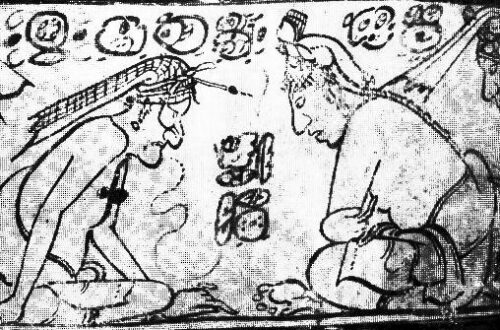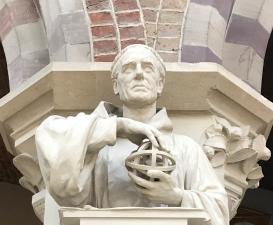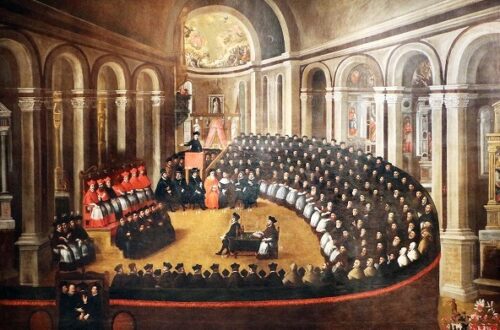
Calender reform and precession jolt
Abstract of the German article “Kalender und Präzessionssprung”
by Ilya U. Topper, Madrid · 2009. This abstract has been written by Uwe Topper
When Pope Gregor XIII intended to reform the calendar he ordered a commission of very learned men to consider the possibilities and consequences. Most important among them was Aloysius Lilius who conceived a textbook which unfortunately never was published (still one of the desiderata in this matter). He died 1576, yet his brother Antonius abriged the text and the following year this „Compendium novae rationis“ of 11 pages was sent to „Christian princes and academicians“ but received little attention.
The most important point of this compendium is the declaration that the course of the sun – and thus the length of the year – is not constant but undergoes variations which had been observed and measured by learned astronomers since many centuries.
According to our present knowledge Lilius would have refered to Hipparchos and the Arab astronomers like Battenius who indeed calculated from observation the length of the tropical year in contrast to the sidereal year and thus used their respective precession factor whereby the Arab results differed from the Greek sources (as well as from our modern measurements). This certainly affects the cardinal points of the calendar (solstices anbd equinoxes) and thus interferes with clerical Easter computations.
We (Uwe & Ilya Topper) have strong arguments to believe that the change of the precession factor did not come about gradually but apruptly by some not yet determined cosmic agent (possibly a fractional change in the electromagnetic sphere of the solar system). We locate this event vaguely around 1300 AD. (The authors earlier, from 2004 onward, had proposed two separate events at 1260 and 1350 but now think that a single event at roughly this time bracket would even better match with historic and traditional reminiscences.)
In order to avoid disputations about the exact length of the solar year the papal commission agreed to use the Alfonsine year (commonly dated to 1252, but supposedly not earlier than 1490). It looks like a compromise between the ancient Greek and the medieval Arab values and is still today useful for all practical purposes.
Why did Pope Gregor XIII insist on having the 21st March as day of the spring equinox? He simply argued that this corresponded to the conviction of the fathers of the council of Nicea, the first ecumenical council of the church. (There is no historical record about which date was in use then but for our present purpose this does not matter). To put the church calendar in concordance with this assumption he had to advance the date by ten units which he ordered to be done in October 1582. In order to make the equinoctial date stay at its fixed place the leap rule was slightly changed, too, as is commonly known. (The new regulations for Easter calculation introduced at the same time do not concern us here).
Protestant churches followed more than a century later, in Germany from 1700 onward, in England in 1752, whereas the orthodox churches and non-Christian groups (like the Berbers) have not yet adopted the new rules.
Popular customs and ancestral rites give strong evidence to different ways of regulating the calendar before the said pope arranged the new regulation four centuries ago. From many accounts and still commonly observed feasts all over Europe we can deduct that in protohistoric times – supposedly from megalithic times onward – the New Year day was determined astronomically and then propagated by fires and lit candles etc. all over the country. Those customs are still in vogue with Catholics in Spain or heathens in Germany, Iranian or Arab Muslims and even Jews all over the world. (For ample information please consult the German text).
The variation of the year length must have been very notable immediately after the aforementioned cosmic event. It was even observed by Greek and Arab astronomers that the spring equinox (to use a fixed date) was moving to and fro which they termed „trepidation“ thus making it impossible to predict the New Year day for a long time lapse in advance. Therefore ad hoc observations and their public announcement by fires and light were a necessity for generations. Even Copernicus took trepidation into consideration in his new planetary model.
Another way of reacting to the unreliability of the sun’s course was to skip a fixed solar year altogether and to use the moon’s course as calendar guide. Thus the islamic regulation abolished the traditional calendar where Muharram had corresponded to January, Rabi‘ I and II to Spring (March and April) and Dhul Hijja to the pilgrimage in December, while Ramadan fell in September, most adapted to the necessity of fasting when water was scarce. The suppressing of the hitherto necessary leap month was ordered by Muhammad in Medina (Sura 9, 36 ff) as widely acknowledged. This means that the start of modern Hijra count is retrocalculated.
The commonly reported Roman combined sun-moon calendar of pre-Cesarian times as well as the Jewish and the Christian liturgic calendars could be reminiscences of the use of a lunar calendar during times of uncertainty.




